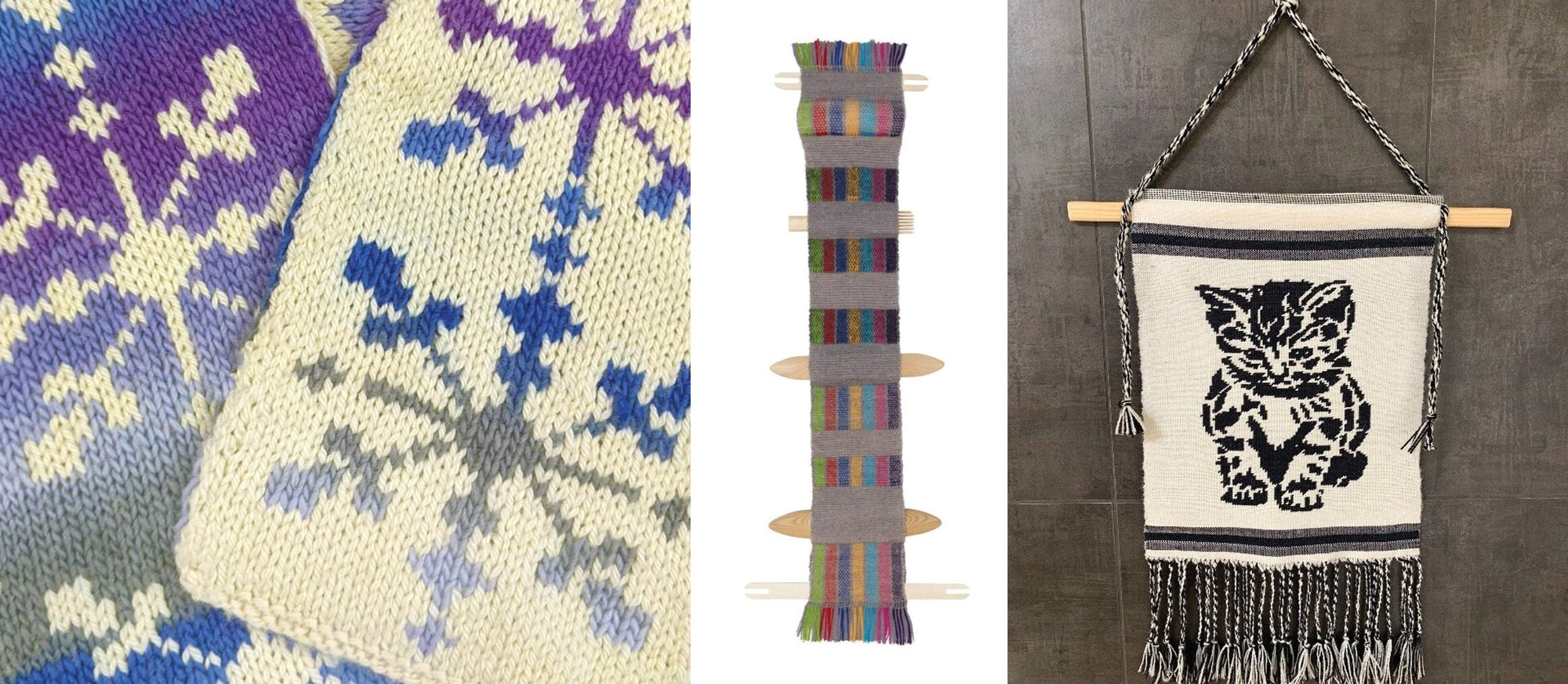By Deb Gerish
If you're a knitter who's weaving-curious, I'm about to offer exciting incentives to get a rigid heddle loom! If you know a knitter who's weaving-curious, tell them to read this article—it might push them into weaving! If you're a knitter who already enjoys weaving, get ready to enjoy it even more! If you're wondering why I'm using so many exclamation points, the short answer is "doubleweave." This amazing technique has an analog in the knitting world called "double knitting." Both doubleweave and double knitting create fabric in layers.
This simple fact opens all kinds of design possibilities. Switch the layers, and you get pockets in the fabric. You can keep the pockets open on one side or both sides. You can close the pockets on both sides to form a tube, which can hold stuffing or anything you want. You can create reversible fabric by switching some warp threads or stitches: they form designs on the fabric that look like photographic negatives of each other.

Leo the Cat Doubleweave—there's a white cat on black on the other side

Deb's Snowflake Knitting—colors reverse on each side!
How does this double magic work? It's a similar process for both crafts—weirdly, because weaving and knitting form fabric so differently. To knit, you put loops of yarn on a needle, then use another needle to pull loops of yarn through these loops, then repeat row by row or round by round. To weave, you put warp yarn on a loom, then interlace weft yarn (wound on a shuttle) over and under the warp, working row by row.

Single layers of weaving (left) and knitting (right)
Imagine that you're setting up a project in double knitting or doubleweave. You want the two-layer fabric to have dark yarn on top and light yarn on the bottom. On the knitting needle, you cast on with dark yarn and light yarn, alternating the colors. To form double-knitted fabric, knit the dark stitches with dark yarn and slip the light stitches; then reverse directions to knit the light stitches with light yarn (slipping the dark stitches).
On the loom, you warp with dark yarn and light yarn, alternating the colors. To form doubleweave fabric, work dark weft over and under the dark warp, and light weft under and over the light warp, using shuttles. It's easy to turn around your knitting needles to work back in the opposite direction. But how do you weave the bottom layer on a loom—flip it upside-down? That would be awkward even on a small rigid heddle loom! Instead, you lift all the top-layer warp threads out of the way and weave the bottom layer, then you weave the top layer. You can't see what's happening on the bottom layer, yet you can trust the loom to do its job.

Double layers of weaving (left) and knitting (right)
For both crafts, you can keep the layers separate, or form them into pockets or tubes, depending on what you do at each selvedge. Don't twist the knitting yarns or weaving shuttles, and the layers stay separate. Twist them around each other, at one or both selvedges, and you've just joined the layers. Double knitting uses this trick all the time for reversible colorwork scarves with the floats sandwiched between the layers (like my Snowflake Scarf above).
Doubleweave, however, offers another design opportunity: switch layers to join them horizontally, while simultaneously switching the warp colors. The red dotted lines on the schematic mark horizontal joins that are functional as well as decorative. You can weave something like this tool holder.

Now imagine the possibilities! Knitters, you could weave a holder with open-sided pockets for all your circular needles: no matter how long the circulars are, they'll fit! Or you could close one side of the pockets to store traditional needles and double-points—you can even vary the height of the pocket to hold needles securely. Make tall pockets, and you can store yarn. In other words, a weaving habit can support your knitting habit. How cool is that?!
You can work this amazing technique on a rigid heddle loom, using two heddles. If you've never woven before, consider a rigid heddle loom: it doesn't require a lot of space or extra equipment. Best of all, beginners can quickly master the basic skills of warping and weaving. Then you can add a second heddle and open up the full potential of your loom.
Schacht covers all the bases for rigid heddle weaving: we make the Flip loom and every accessory you can imagine. When you're ready for two-heddle weaving, learn from a master—Jane Patrick now offers classes for these techniques.

